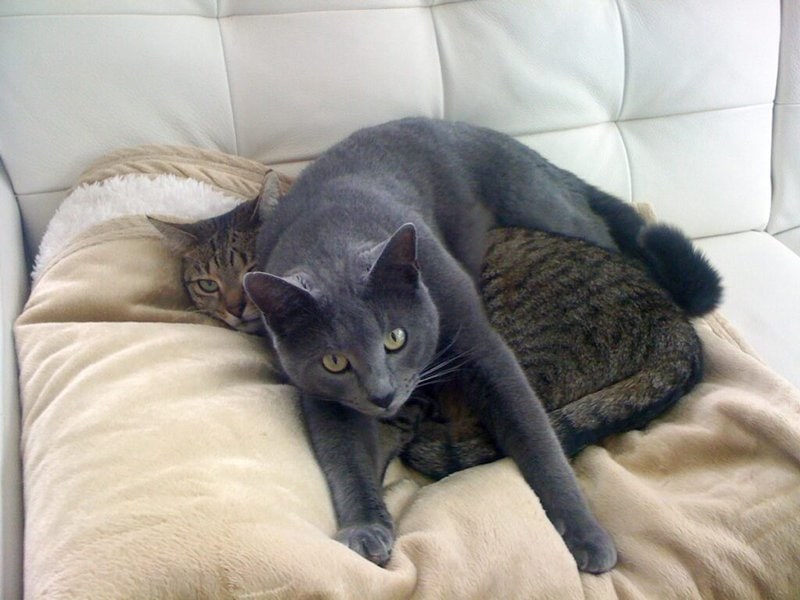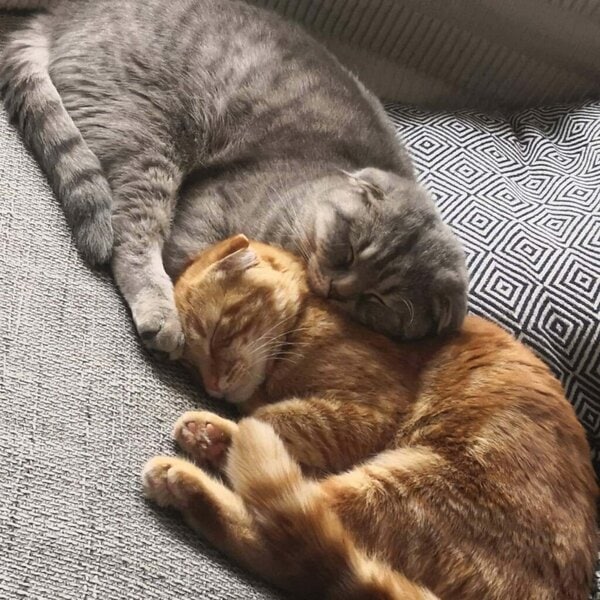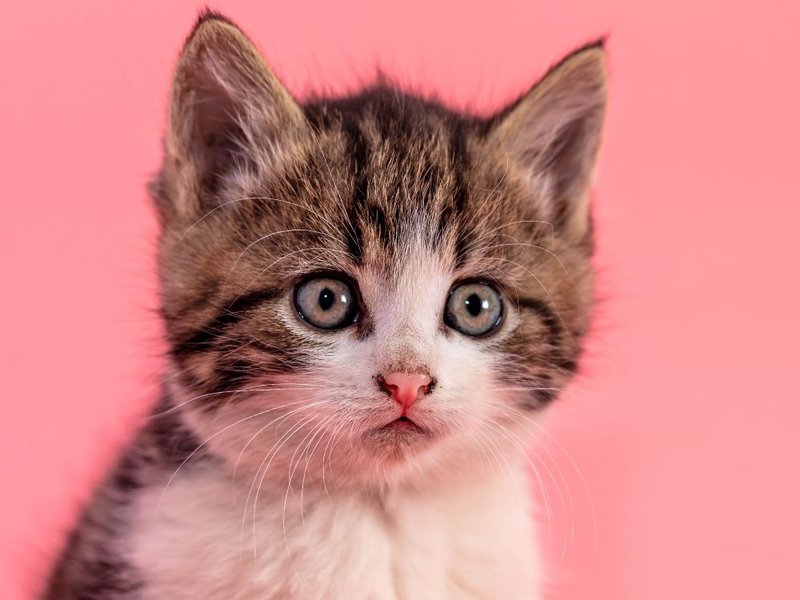Your cat has recently delivered a litter of kittens, but you’re having a hard time telling which of your little furry friends is male or female. Lucky for you, there are several ways by which you can deduce a kitten’s sex and that’s what we’ll be looking at in this article.
How then can you tell the sex of a kitten? You can determine a kitten’s sex by either examining its genitals at birth, looking for differences in coat color and patterns, or studying its sex-related behavior. These methods vary in accuracy, with the genital examination being the closest thing to a genetic test.
At what age is it appropriate to carry out a gender check on a kitten? And based on behavior, is it better for you to raise a male or female kitten? These and many more questions will be answered below. But first, let’s see what kittens’ privates look like.
What Does A Male Kittens’ Privates Look Like?
The first and most commonly used method of distinguishing between a male and a female kitten is by examining both their genitals a few weeks after they are born.
Steps To Take Before Examining a Kitten’s Privates
Kittens are quite sensitive and fragile at the earlier stages of their life, and you can’t just pick a new-born cat from its litter and start prodding around to determine its sex.
To ensure the examination of your kitten’s privates is a hitch-free process, there are things you need to put in place and these include:
- Ensure the kitten is in a calm, docile mood – preferably immediately after finishing a meal.
- Make arrangements to pacify and distract the kitten’s mother to prevent agitation – a treat or a toy could help greatly.
- Prepare a warm, non-heat seeking surface to place the kitten on while you examine its privates.
- Make sure you don’t separate a kitten from its mother for more than 10 minutes.
How To Examine A Kitten’s Privates?
After putting the necessary measures in place, you can then proceed to examine the kitten’s privates in a bid to determine its sex. To do this:
- Gently pick the kitty cat from its litter, then pet and snuggle it close to your body to reassure it and eliminate fear and anxiety.
- Place the kitty cat on a non-slip surface – preferably a large towel on a table
- Gently lift the kitty cat’s tail, taking care not to agitate it. Alternatively, you could gently scratch the kitty cat’s back, where the tail meets the body, and the tail will be automatically lifted.
What Does A Male Kitten’s Privates Look Like?
A male cat typically has two private openings – the anus on top and the genitalia (or penis) directly below it. And for male cats, both the anus and the genital opening are in the form of a round hole – just like a colon (:).

Additionally, you could check for the presence of a testicle, although this is usually not prominent in younger male cats. To do this, gently prod between the kitten’s anus and genital opening. If you feel tiny, pea-sized lumps, this indicates the presence of testicles, thus implying that the kitten is male.
What Does A Female Kitten’s Privates Look Like?
Female kittens, just like their male counterparts typically have two holes in their private regions – the anus and the genital opening (or vulva).
In female kittens, the anal opening is a round hole, and the genital opening below it is a small, vertical hole – think of it as looking like the small letter ‘i’.
Differences Between Male And Female Kittens Privates
Now that you know what the privates look like in male and female kittens, there are certain distinguishable features to tell you whether your kitty cat is a Tom or a ‘Queen’.
- For one, the genital opening in male cats is a round hole, while it is a vertical slit for female cats.
- Also, the distance between the anus and the genital opening in male kittens is wider than what is obtainable with female kitties.
How Can You Tell A Kitten’s Gender By Color?
Apart from examining the genitals, you can tell a male kitten apart from a female kitten by looking out for noticeable differences in coat colors and patterns.
However, this is typically less reliable than checking out your kittens’ privates and is mostly useful for telling if a kitten is a boy or a girl from a picture.

Are Orange Or Ginger Cats Always Male?
In most cases, Ginger or Orange colored kittens are more likely to be male than female. However, it is possible to get an orange-colored female kitten, if both parents have orange coats or due to its genetic makeup which is further explained below.
How Genetics Affect Kittens’ Coat Color Patterns?
Certain coat color patterns such as calico (white coat, with large orange and black patches) and tortoiseshell (shades of red and black, white in some cases) only appear on cats due to the presence of the XX female chromosome; Hence, a kitten sporting either of these patterns is most likely female.
In rare (1 in 3,000 cats) genetic cases, it is possible for male kittens to be born with the XXY chromosome (known as the Klinefelter syndrome). And in such cases, you’ll have a male cat sporting three-colored calico or tortoiseshell coats.
Why Are Most Black Cats Male?
The majority of the black cats you’ll come across are male due to the genetic makeup of felines. Most times, cats are either born with the XY male chromosome or the XX female chromosome. The X part of the chromosomes in cats carries the color genes which is, most times, either black or orange/variations of orange.
X alleles in chromosomes can only carry one color at a time. And because male kittens have just one X allele, a kitten with a pure black or orange coat will most likely be a Tom. Female kittens can also be purely black or orange if they carry the same color on both X chromosomes.
At What Age Can You Tell A Kitten’s Gender?
You can determine a kitten’s gender as soon as it’s born, although I’d recommend you wait 2 to 3 weeks after birth to carry out this ‘gender-determining exercise’. And this exercise will mostly require you to carry out a genital check on the kitten.

However, if you’re patient enough, you can wait till 9 to 12 months after birth, when a kitten is attaining peak maturity, to determine its sex. At this stage of a kitten’s life, it’ll start to display sexual and unique personalities typical with both cat genders.
Signs Of Heat
Unspayed female kittens typically begin to show signs of heat from as early as four months old, and these can be used to tell whether a kitty cat is a ‘Queen’. Some of the telltale behaviors of a female kitten in heat include:
- A strong, unusual urge to go outside the house.
- Excessive display of affection – this can be particularly telling if your kitty cat is normally not affectionate.
- Heat displays, such as stretching out on the forelegs, and extending the rear end into the air, with the tail tilted to the side.
- Restlessness, coupled with excessive meowing or moaning.
Territorial Behavior
Cats are highly territorial animals, and as they grow older, the urge to stake their claim and mark boundaries around the home increases. If you have a kitten that keeps peeing on your bed, it is probably just trying to stake its claim on the bed.
Kittens mostly pee while sitting, hence if you notice one of your furry friends squirting urine and wagging its tail, while backed up against a vertical surface, then it is spraying.
Both male and female cats spray urine, hence this is not a foolproof method of telling a kitten’s sex. An unneutered male cat tends to spray stronger-smelling urine more frequently, and this can help you distinguish it from its fellow female culprit.
Are Male Kittens More Aggressive Than Females?
Another way to distinguish between male and female kittens is to observe behavioral differences of the felines in your litter as they grow. Behavioral differences between a male and a female kitten are mostly due to how they act during sexual maturity and are best observed in unneutered or unspayed kittens.

Are Male Or Female Kittens Friendlier?
The general consensus is that male cats tend to be more affectionate towards humans while female cats, because of their mothering instincts, are meaner and initially less trusting of humans. This could be no further from the truth, and your kitten’s friendliness is ultimately down to its individual personality.
However, when your kitty cat is ready to start mating, it’s a different ball game entirely.
Heat-Related Aggression
Unspayed female kittens tend to switch up and become more loving whenever they’re on heat. These ‘Queens’ will howl and prowl around in search of a prospective partner, but they usually don’t display aggressive behavior.
Unneutered tomcats, in contrast, typically become more aggressive, spray urine everywhere, and will try several times, to escape the house at the peak of their sexual maturity. These unneutered tomcats will also aggressively defend their homes or territories from whatever they perceive to be a threat.
Is There Really A Personality Difference Between Male And Female Kittens?
Neutering or spaying your Kittens will eliminate most of the sexual behaviors listed above. And your feline’s personality – both male and female – going forward, will depend on your behavior towards them, and not gender. Other factors that may influence your kitten’s personality include its level of socialization and the nature of the environment.
Should I Get A Male Or Female Kitten?
If you’re looking to get your very own kitten and start a litter of cats; Or you’re a single cat owner looking to get a feline companion for your furry friend, a logical question would be whether to get a male or a female kitten.
Pairing A New Kitten With Your Old Cat
As a cat owner, one of the greatest gifts you can give your furry friend is another feline companion. Cats are highly social animals and bonded pairs of cats are typically happier and healthier from playing and eating together.

Male cats will get along well with female kittens in the same way female cats will get along with make kittens. Additionally, you can pair cats of the same gender together, although this will be significantly more difficult if they’re both unneutered or unspayed adults.
If you plan to own and raise cats of different genders for non-breeding purposes, then it’d be in your best interest to neuter and spay them as soon as possible to prevent sexual-based aggression.
How Do Male Cats React To Kittens?
If you already own a male cat, you can expect it to express its displeasure at the introduction of a new kitten by displaying territorial behavior such as urine spraying, stalking the new kitten, growling, or hissing.
Not to worry though, this behavior is completely normal, and with time and gradual introduction of both felines to each other, they will eventually get along fine.
Also, while tomcats can form good relationships with younger felines, an unneutered male cat is a threat to kittens belonging to another male cat; Hence, you should take care and pay attention when introducing them to each other. Unrelated female cats are less likely to be aggressive towards each other, but will only compete for your attention and care.
Related Questions
Do Male Or Female Cats Live Longer? Kittens will live, on average, for anywhere between 13 to 17 years. Several studies have shown that female kittens tend to outlive their male counterparts by 1 to 2 years, but this is not set in stone. And how long your kitten will live is ultimately dependent on factors such as its breed, environment, health, and maintenance.
Do Cuddly Kittens Stay Cuddly? There is no evidence to conclude that cats naturally cuddle more with age. However, if you have a cuddly kitten, there is every chance that it’ll grow to become a cuddly cat. You should also know that a kitten will only continue reciprocating the behavior it’s shown as it grows; Hence, if you want a cuddly kitten to stay cuddly as an adult, continue to shower it with loads of affection.
Is It Better To Have 1 Kitten Or 2? Indoor cats do very well when they have feline company while the owner is away, but they can also be very solitary animals, hence it is not necessarily cruel to have just one cat. The need for companionship varies from cat to cat and felines used to human affection will do just fine on their own.





